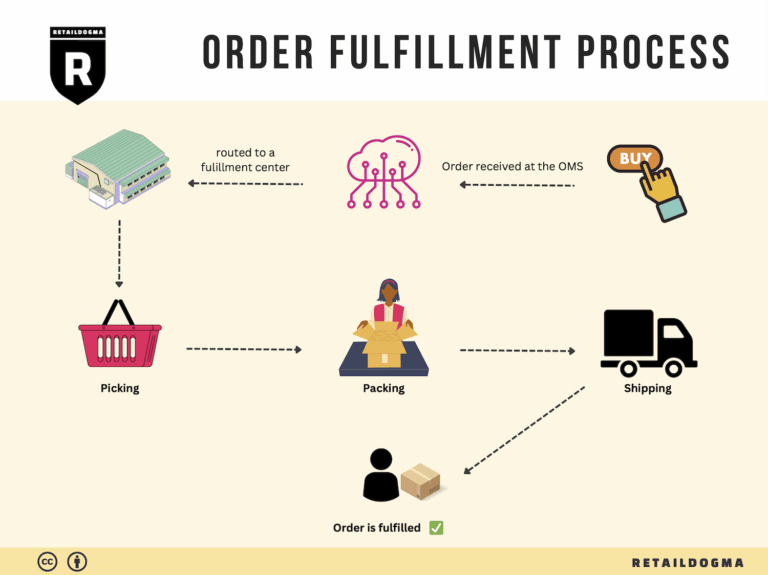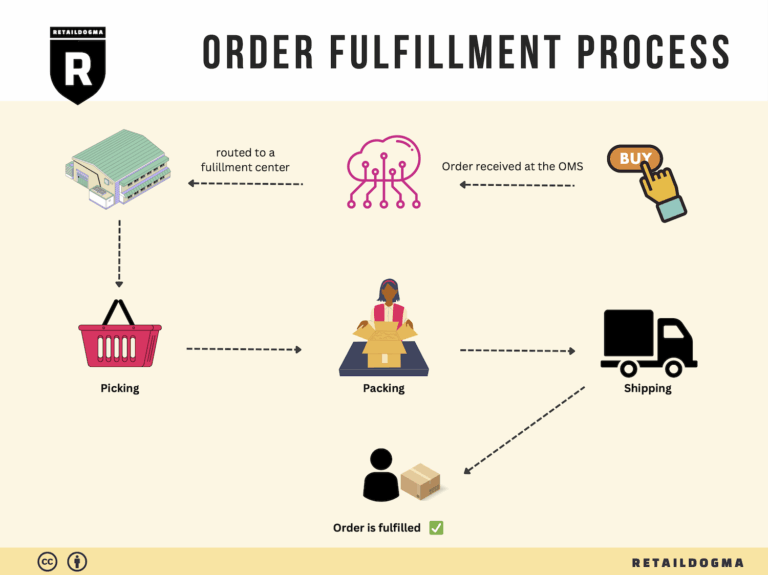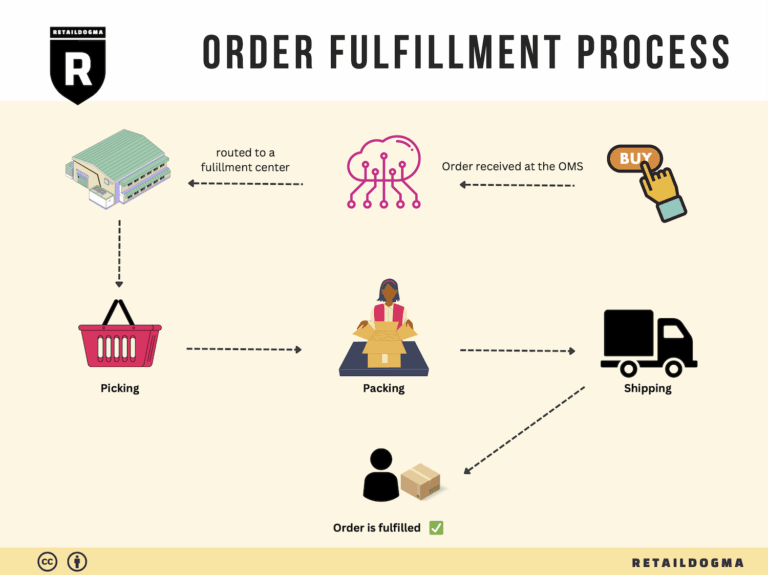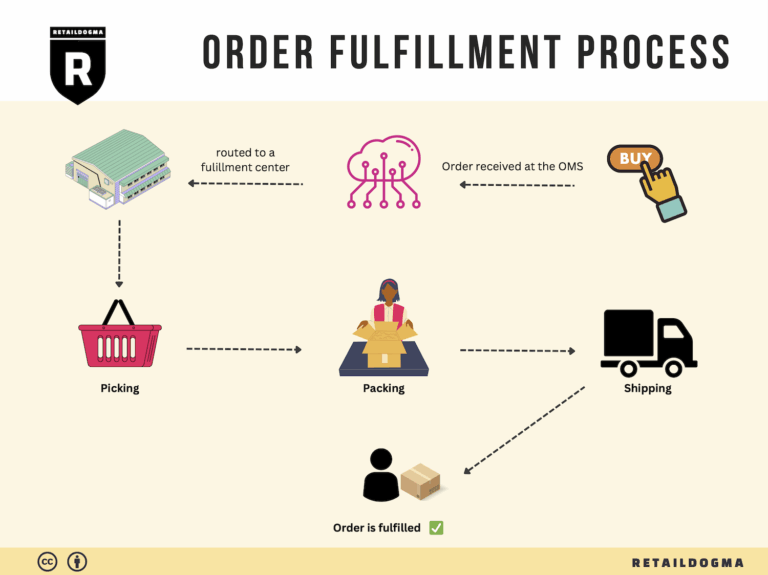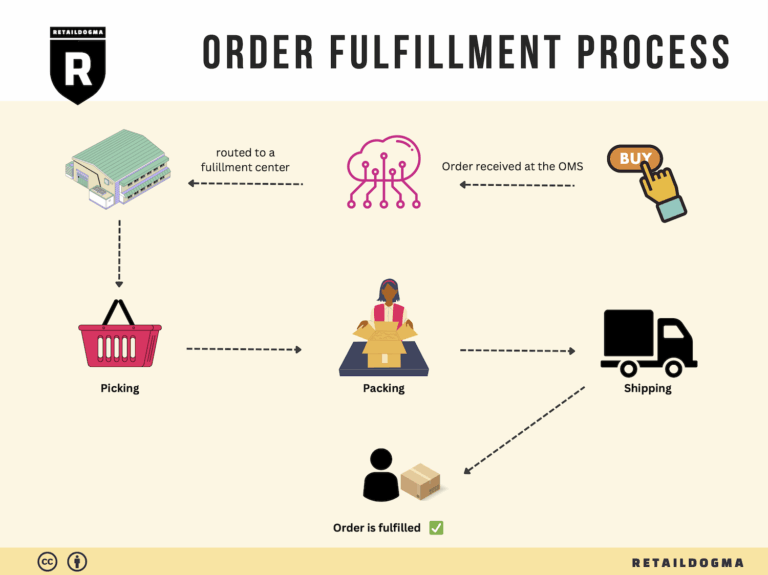What Is A Fulfillment Center? A Complete Guide (2025)
What is E-commerce Fulfillment? An Introduction for Growing Businesses
Understanding E-commerce Fulfillment: A Critical Component for Growth
For many growing e-commerce businesses, the process of packing and shipping orders can quickly become overwhelming. As sales increase, so does the complexity of logistics—balancing inventory management, order processing, and customer expectations can feel like a daunting task. This is where fulfillment comes into play. Simply put, fulfillment is the comprehensive process of getting a product from your inventory to your customer’s doorstep. It encompasses everything from order receipt and inventory management to packing, shipping, and handling returns.
This guide aims to demystify e-commerce fulfillment for business owners, operations managers, and entrepreneurs who are eager to scale their operations effectively. We’ll explore various fulfillment models, including Third-Party Logistics (3PL) and Fulfillment by Amazon (FBA), each of which offers unique advantages and challenges. Understanding these models is crucial for selecting the right approach to meet your business’s needs.
We’ll delve into the core services provided by fulfillment partners, such as inventory storage, order processing, and shipping logistics. These services can vary significantly between providers, so having a clear grasp of what each partner offers will help you make informed decisions.
Moreover, choosing the right fulfillment partner is a pivotal step in your e-commerce journey. We’ll discuss key factors to consider, such as location, technology integration, service levels, and scalability. A well-chosen partner can not only streamline your operations but also enhance customer satisfaction—an essential element for repeat business.
Finally, we will cover pricing structures associated with different fulfillment options. Understanding these costs, including shipping fees, storage fees, and additional service charges, will empower you to budget effectively and maintain healthy profit margins.
Our goal with this guide is to equip you with the knowledge necessary to make smart, strategic decisions about your logistics. By understanding the landscape of e-commerce fulfillment, you can position your business for sustainable growth, ensuring that your logistics are as efficient as your sales strategy. Let’s dive in and take the first step toward optimizing your fulfillment processes!
What You’ll Learn In This Guide
- What is E-commerce Fulfillment? An Introduction for Growing Businesses
- The Order Fulfillment Process: From ‘Buy’ Button to Customer’s Door
- Comparing Fulfillment Models: In-House vs. 3PL vs. Dropshipping
- A Deep Dive into Amazon FBA: Pros, Cons, and Who It’s For
- Core Services Offered by Fulfillment Centers
- How to Choose a Fulfillment Partner: A 6-Point Checklist
- Understanding Fulfillment Pricing: A Breakdown of Common Fees
- Frequently Asked Questions (FAQs) about Fulfillment
- Conclusion: Is Outsourcing Fulfillment the Right Move for Your Business?
- Important Disclaimer
The Order Fulfillment Process: From ‘Buy’ Button to Customer’s Door
1. Receiving Inventory
The first step in the order fulfillment process is receiving inventory. Once products are sourced from suppliers, they arrive at the fulfillment center or warehouse. During this stage, the inventory is checked against purchase orders to ensure accuracy in terms of quantity and condition. Each item is assigned a Stock Keeping Unit (SKU), a unique identifier that allows for easy tracking of products throughout the fulfillment process.
Importance: Accurate receiving is crucial as it establishes the foundation for inventory management. Errors at this stage can lead to stock discrepancies, which can affect order accuracy and customer satisfaction. A well-organized receiving process helps to minimize these risks.
Key Term: SKU (Stock Keeping Unit) – A unique identifier for each product that aids in inventory tracking and management.
2. Warehouse Storage
After receiving inventory, the next step is warehouse storage. This involves organizing the products within the fulfillment center to maximize efficiency and accessibility. Items are typically stored based on a systematic approach, often categorized by product type, size, or sales velocity. Utilizing a warehouse management system (WMS) can greatly enhance the organization of stock.
Importance: Proper storage is essential for quick retrieval of items during order picking. An efficient storage strategy reduces the time workers spend locating products, thereby speeding up the entire fulfillment process. Additionally, it helps in maintaining inventory accuracy and reduces the risk of stockouts or overstock situations.
Key Term: Warehouse Management System (WMS) – Software that supports the daily operations of a warehouse, including inventory tracking, order processing, and storage optimization.
3. Order Picking
Order picking is the process where items are selected from storage to fulfill customer orders. Once an order is placed, the fulfillment center generates a pick list, which details the items and their locations within the warehouse. Workers then use this list to collect the necessary products.
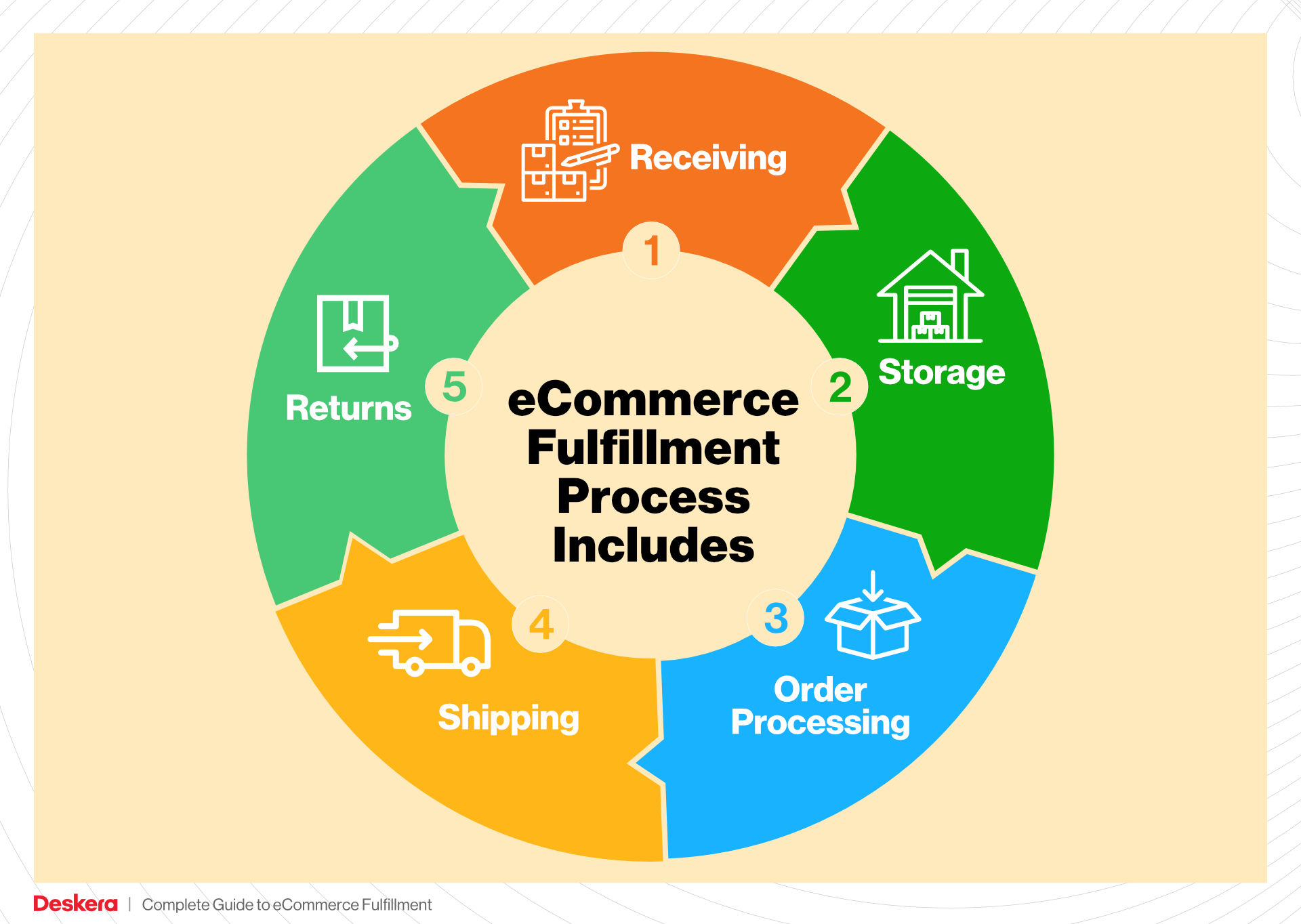
Importance: Efficient order picking is vital for maintaining fast turnaround times and meeting customer expectations. The speed and accuracy of picking directly impact order fulfillment rates and customer satisfaction. Implementing strategies like batch picking (picking multiple orders at once) or zone picking (assigning specific areas to individual pickers) can enhance efficiency.
Key Term: Pick List – A document generated for order fulfillment that outlines the items to be picked and their locations within the warehouse.
4. Order Packing
Once the items are picked, the next step is order packing. This involves carefully packing the selected items into boxes or containers, ensuring they are secured for transport. Packaging materials such as bubble wrap, packing peanuts, or air pillows may be used to protect fragile items. Additionally, packing slips and invoices are included in the shipment.
Importance: Effective packing minimizes the risk of damage during shipping, which is crucial for maintaining customer satisfaction. Properly packed orders can also optimize shipping costs by reducing dimensional weight and ensuring compliance with carrier requirements. Furthermore, branded packaging can enhance customer experience and promote brand loyalty.
Key Term: Packing Slip – A document included in the shipment that lists the contents of the package and confirms what was sent to the customer.
5. Shipping & Delivery
The final step in the order fulfillment process is shipping and delivery. Once the orders are packed, they are labeled and handed over to shipping carriers for delivery. Businesses often choose between various carriers based on cost, speed, and reliability. Tracking numbers are usually generated to allow customers to monitor their orders in transit.
Importance: Timely shipping and reliable delivery are critical for customer satisfaction and retention. The speed and accuracy of this final step can greatly influence a customer’s perception of a brand. Implementing a robust shipping strategy, including options for expedited delivery, can enhance the customer experience and drive repeat business.
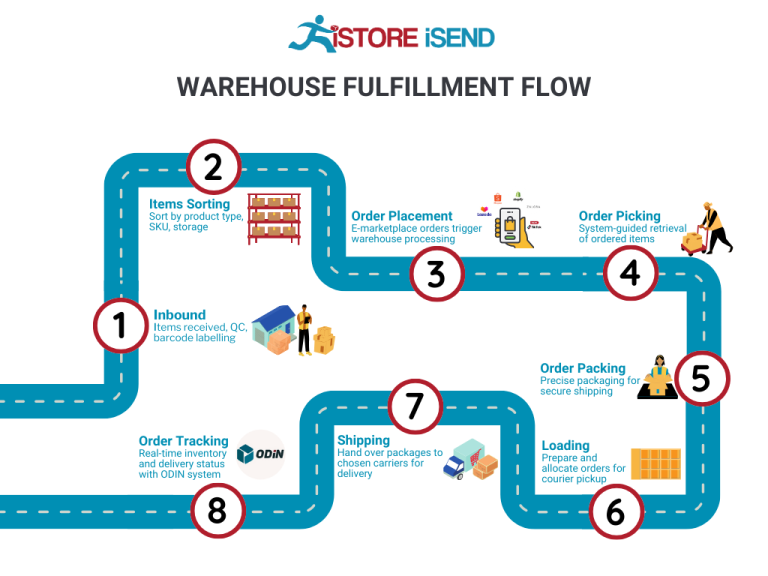
Key Term: Tracking Number – A unique identifier assigned to a package that allows customers to monitor its delivery status in real-time.
By understanding and optimizing each step of the order fulfillment process, e-commerce businesses can significantly improve operational efficiency and enhance customer satisfaction, ultimately leading to growth and profitability.
Comparing Fulfillment Models: In-House vs. 3PL vs. Dropshipping
Comparison of Fulfillment Models
| Model | Who Handles Inventory | Best For (Business Stage) | Key Advantage | Key Disadvantage |
|---|---|---|---|---|
| In-House Fulfillment | The business itself | Startups and established businesses | Full control over inventory and processes | High overhead costs and resource intensive |
| Third-Party Logistics (3PL) | 3PL provider | Growing and scaling businesses | Cost-effective and scalable logistics solutions | Less control over fulfillment operations |
| Dropshipping | Supplier or manufacturer | New entrepreneurs and small businesses | Low startup costs and minimal risk | Lower profit margins and dependency on suppliers |
In-House Fulfillment
In-house fulfillment involves managing all aspects of inventory, warehousing, and shipping within your own facilities. This model is often favored by startups and established businesses that want full control over their logistics processes. By handling fulfillment internally, businesses can customize their operations to meet specific needs, which can enhance customer satisfaction through faster shipping times and personalized service. However, this model comes with significant overhead costs, including the expenses associated with renting warehouse space, hiring staff, and maintaining inventory. As businesses scale, these costs can become burdensome, potentially limiting growth and agility. Additionally, in-house fulfillment requires a substantial investment in technology and systems to manage inventory efficiently, which can be a challenge for smaller businesses.
Third-Party Logistics (3PL)
Third-party logistics (3PL) involves outsourcing fulfillment tasks to specialized logistics providers. This model is particularly advantageous for growing and scaling businesses that require flexible logistics solutions without the burden of managing everything in-house. 3PL providers typically offer a range of services, including warehousing, inventory management, order processing, and shipping. By leveraging a 3PL, businesses can reduce operational costs, access advanced logistics technology, and scale their operations more easily without investing heavily in infrastructure. The downside, however, is the reduced control over fulfillment processes, which can lead to inconsistencies in service quality or shipping times if the 3PL does not meet expectations. Moreover, businesses must ensure strong communication and integration with their 3PL partner to avoid potential disruptions in the supply chain.
Dropshipping
Dropshipping is a fulfillment model where the retailer does not hold inventory but instead transfers customer orders directly to a supplier or manufacturer, who then ships the products directly to the customer. This model is ideal for new entrepreneurs and small businesses due to its low startup costs and minimal risk, as there is no need to invest in inventory upfront. Additionally, dropshipping allows for a wide product selection without the financial burden of stocking items. However, dropshipping typically comes with lower profit margins since suppliers often charge higher prices for their products. Furthermore, businesses are dependent on suppliers for inventory management and fulfillment, which can lead to challenges such as stock shortages, shipping delays, or quality control issues. This lack of control can impact customer satisfaction and brand reputation if not managed carefully.
Conclusion
Each fulfillment model presents distinct advantages and disadvantages that can significantly impact an e-commerce business’s operations and growth trajectory. Choosing the right model depends on various factors, including business size, growth stage, and operational goals. By evaluating these models carefully, business owners can make informed decisions that align with their strategic objectives and customer expectations.
A Deep Dive into Amazon FBA: Pros, Cons, and Who It’s For
Understanding Fulfillment by Amazon (FBA)
Fulfillment by Amazon (FBA) is a service provided by Amazon that enables sellers to store their products in Amazon’s fulfillment centers. Amazon takes care of storage, packaging, and shipping of these products directly to customers. In addition to logistics, FBA also handles customer service and returns for these orders. This allows sellers to leverage Amazon’s vast logistics network and customer base, streamlining their operations significantly.
How FBA Works
-
Product Listing: Sellers create product listings on Amazon and choose to use FBA. They must ensure their products comply with Amazon’s guidelines.
-
Shipping to Amazon: Sellers send their products to Amazon’s fulfillment centers. Amazon provides specific guidelines on how to prepare and package items for shipping.
-
Storage and Inventory Management: Once products arrive at the fulfillment center, they are stored until sold. Amazon manages the inventory and ensures that products are available for customers.
-
Order Fulfillment: When a customer places an order, Amazon picks, packs, and ships the product. The seller benefits from Amazon’s Prime eligibility, which can significantly increase visibility and sales.

-
Customer Service and Returns: Amazon handles all customer inquiries and return processes, allowing sellers to focus on scaling their business rather than logistics.
Pros of Using Amazon FBA
1. Prime Eligibility
One of the most significant advantages of FBA is that products become eligible for Amazon Prime. Prime members enjoy free two-day shipping, which can lead to increased sales. This exclusivity often attracts customers who prefer the convenience and speed of Prime shipping.
2. Customer Trust
Amazon is a well-established brand with a reputation for reliability. When sellers use FBA, their products are associated with this trust. Customers are more likely to purchase items fulfilled by Amazon due to the assurance of quality service, including prompt shipping and hassle-free returns.
3. Multi-Channel Fulfillment
FBA is not limited to sales on Amazon alone. Sellers can utilize FBA to fulfill orders from other sales channels, such as their own e-commerce websites or platforms like eBay. This flexibility allows businesses to streamline operations by using one fulfillment service across multiple platforms.
4. Simplified Logistics
By outsourcing logistics to Amazon, sellers can save time and resources. Amazon’s fulfillment centers are equipped with advanced technology and systems that manage inventory, reducing the burden of warehousing and order processing for sellers.
5. Scalability
FBA allows sellers to scale their business quickly. As demand for products increases, sellers can send more inventory to Amazon without worrying about the logistics involved in storage and shipping.
Cons of Using Amazon FBA
1. High Fees
FBA comes with a variety of fees that can eat into profit margins. These include referral fees, fulfillment fees, and storage fees. Sellers must carefully calculate these costs using tools like the Amazon FBA Calculator to ensure their pricing strategy remains profitable.
2. Strict Inventory Rules
Amazon has stringent policies regarding inventory management. Sellers must adhere to guidelines on storage limits, and failure to comply can result in additional fees or restrictions on selling privileges. This can complicate inventory planning and forecasting.
3. Commingling Risks
FBA uses a commingled inventory system, which means that sellers’ products are stored alongside those of other sellers. This can lead to challenges if a customer returns a product that is not in good condition or if another seller’s inventory is mistakenly sent to a customer. Sellers may lose control over their brand representation and product quality.
4. Limited Control Over Branding
When using FBA, sellers have less control over the packaging and presentation of their products. Amazon handles all fulfillment, which may not align with a seller’s branding strategy. This can dilute brand identity and customer experience.
5. Long-Term Storage Fees
Sellers must be mindful of long-term storage fees, which apply to inventory stored in Amazon’s fulfillment centers for more than six months. This can incentivize sellers to manage their inventory more proactively, but it also adds pressure to sell products quickly.
Who is FBA Best For?
Fulfillment by Amazon is particularly suited for:
-
Small to Medium-Sized Businesses: Businesses looking to expand their reach without investing heavily in logistics can benefit greatly from FBA’s services.
-
Retail Arbitrage Sellers: Those who buy products at lower prices to sell on Amazon can leverage FBA to manage fulfillment efficiently, allowing them to focus on sourcing new products.
-
Private Label Sellers: Businesses that create their own branded products can enhance visibility and trust through FBA, taking advantage of Amazon’s extensive customer base.
-
Sellers with High Sales Volume: For sellers experiencing rapid growth, FBA provides the infrastructure needed to scale operations quickly without the overhead of managing logistics.
-
Multi-Channel Sellers: Businesses that sell across different platforms can streamline their fulfillment process by using FBA to handle all shipping and customer service, regardless of where the sale occurs.
In conclusion, while FBA offers significant advantages in terms of logistics, customer trust, and scalability, potential sellers must carefully weigh these benefits against the associated costs and limitations. For many, the trade-offs make FBA an invaluable tool in the e-commerce landscape, particularly for those looking to grow their business efficiently.
Core Services Offered by Fulfillment Centers
Inventory Management & Warehousing
Inventory management and warehousing are foundational services provided by fulfillment centers that enable e-commerce businesses to maintain optimal stock levels while minimizing overhead costs. Fulfillment centers utilize advanced inventory management systems to track stock levels, monitor sales trends, and forecast demand. This allows businesses to make informed decisions about purchasing and restocking, ensuring that popular items are always available without incurring unnecessary carrying costs.
The benefit of effective inventory management extends beyond mere stock availability. By utilizing a fulfillment center’s warehousing services, e-commerce businesses can reduce the need for large physical retail spaces, lower operational costs, and streamline their logistics. Furthermore, many fulfillment centers offer climate-controlled storage options for sensitive products, enhancing product longevity and quality. Real-time inventory visibility also facilitates better cash flow management, as businesses can align purchasing strategies with sales forecasts, reducing the risk of overstocking or stockouts.
Pick and Pack Services
Pick and pack services are critical to the operational efficiency of e-commerce businesses. This process involves selecting individual items from inventory (picking) and packaging them for shipment (packing). Fulfillment centers employ trained staff and sophisticated technology to ensure that orders are fulfilled accurately and swiftly. Automated systems can streamline these processes, reducing the time taken to prepare orders and minimizing human error.
The benefits of pick and pack services are manifold. Firstly, they enhance order accuracy, which is essential for maintaining customer satisfaction and trust. A well-executed pick and pack operation can significantly reduce shipping times, allowing businesses to offer expedited shipping options that appeal to today’s consumers. Additionally, outsourcing this service allows businesses to focus on core activities such as marketing and product development, rather than getting bogged down in logistical tasks. Overall, efficient pick and pack services can improve order turnaround times, boost customer loyalty, and ultimately drive sales growth.
Kitting and Assembly
Kitting and assembly refer to the process of combining multiple products or components into a single ready-to-sell unit. This service is particularly beneficial for businesses that sell products requiring assembly or those that wish to create bundled offerings. Fulfillment centers can handle the kitting process, ensuring that all components are correctly assembled and packaged for shipping.
The advantages of kitting and assembly services are substantial for e-commerce businesses. By offering bundled products, businesses can increase average order value and enhance customer experience through convenience. Moreover, outsourcing this process to fulfillment centers saves time and resources, allowing businesses to scale their offerings without investing heavily in additional labor or equipment. This service also enables businesses to respond quickly to market trends and customer demands by easily introducing new product bundles or limited-time offers.
Returns Management (Reverse Logistics)
Returns management, often referred to as reverse logistics, encompasses the processes involved in handling product returns from customers. Fulfillment centers provide comprehensive returns management services, including processing returns, inspecting items, restocking, and managing refunds or exchanges. This is particularly crucial in the e-commerce sector, where return rates can be significantly higher than in traditional retail.
The benefits of efficient returns management are twofold. Firstly, a streamlined returns process enhances customer satisfaction by making it easy for customers to return unwanted products, thus fostering loyalty and encouraging repeat business. Secondly, effective returns management can minimize the financial impact of returns on a business. By efficiently inspecting and restocking returned items, fulfillment centers can help recover lost revenue and reduce waste. Furthermore, businesses can gain valuable insights into return reasons, allowing them to identify potential product issues and make necessary adjustments to improve quality and reduce future returns.
In conclusion, fulfillment centers offer a suite of core services that can significantly enhance the operational capabilities of e-commerce businesses. By leveraging these services—inventory management and warehousing, pick and pack, kitting and assembly, and returns management—businesses can optimize their logistics, improve customer satisfaction, and ultimately drive growth in a competitive online marketplace.
How to Choose a Fulfillment Partner: A 6-Point Checklist
Location & Warehouse Network
Choosing a fulfillment partner with strategically located warehouses is essential for reducing shipping times and costs. A well-distributed network allows for faster deliveries, which can enhance customer satisfaction and potentially lower shipping expenses.
Questions to Ask:
- Where are your warehouses located, and how do they align with my target market?
- What is your average shipping time for different regions?
- Can you accommodate seasonal fluctuations in demand with your current warehouse network?
Technology & Integrations
In today’s e-commerce landscape, robust technology is crucial for smooth operations. Your fulfillment partner should offer a system that integrates seamlessly with your existing e-commerce platforms, inventory management systems, and customer relationship management (CRM) tools.
Questions to Ask:
- What technology do you use for inventory management, order processing, and tracking?
- Can your system integrate with platforms like Shopify, Amazon, or WooCommerce?
- How do you handle real-time inventory updates and notifications for stock levels?
Specializations (e.g., Cold Storage, Oversized Items)
Depending on your product range, you may require specific capabilities such as cold storage for perishables or specialized handling for oversized items. It’s critical to partner with a fulfillment provider that can meet these specialized needs without compromising on service quality.
Questions to Ask:
- Do you have experience handling products similar to mine, such as food, electronics, or fragile items?
- What specialized services do you offer, such as temperature-controlled storage or kitting?
- How do you ensure compliance with regulations related to specialized storage or handling?
Scalability & Capacity
As your business grows, your fulfillment partner must be able to scale operations accordingly. They should have the capacity to handle increased order volumes without delays or disruptions.
Questions to Ask:
- How do you manage scaling during peak seasons or unexpected demand surges?
- What is your current capacity, and how easily can you expand it?
- Can you provide case studies or examples of how you’ve successfully scaled for other clients?
Pricing and Contracts
Understanding the pricing structure and contract terms is vital to avoid unexpected costs that can erode your profit margins. Look for transparency in fees, including storage, pick-and-pack, shipping, and any additional services.
Questions to Ask:
- Can you provide a detailed breakdown of all costs associated with your services?
- Are there any hidden fees I should be aware of, such as long-term storage or return processing fees?
- What are the terms of your contracts, and is there flexibility for renegotiation as my business evolves?
Customer Support & Reviews
Reliable customer support can significantly impact your fulfillment experience. A partner with a strong reputation for customer service will help resolve issues quickly and maintain a smooth operation.
Questions to Ask:
- What kind of customer support do you offer (e.g., dedicated account manager, 24/7 support)?
- Can you provide references or testimonials from current or past clients?
- How do you handle disputes or issues related to order fulfillment, and what is your escalation process?
Conclusion
Choosing the right fulfillment partner is a critical decision that can significantly affect your e-commerce operations. By carefully evaluating potential partners against this checklist, you can ensure that you select a provider capable of supporting your business’s current needs and future growth. The right partner will not only enhance your logistics capabilities but also contribute to a better customer experience, ultimately driving your business success.
Understanding Fulfillment Pricing: A Breakdown of Common Fees
Initial Setup Fees
When entering the world of e-commerce fulfillment, businesses often encounter initial setup fees. These fees cover the costs associated with establishing your account with a fulfillment center, such as Amazon FBA, and may include onboarding assistance, system integration, and training for your team.
The calculation of initial setup fees can vary significantly based on the fulfillment provider. Some may charge a flat fee, while others might scale their fees based on your business size or anticipated order volume. It’s essential to understand these fees upfront as they can impact your initial cash flow. For instance, if you’re a startup, seek providers that offer minimal or no setup costs to avoid unnecessary financial strain.
Receiving Fees
Receiving fees are incurred when your products arrive at the fulfillment center. This fee covers the labor and processes involved in unloading, inspecting, and storing your inventory. The calculation for receiving fees typically depends on the volume and weight of your shipments. For instance, many fulfillment centers charge per pallet or per item, with additional costs for items that require special handling or inspection.
To manage receiving fees effectively, consider consolidating shipments to reduce the frequency of deliveries, as each individual shipment may attract separate fees. Additionally, ensure that your products are properly labeled and packaged to avoid any additional charges for handling or rework.
Storage Fees (per pallet/bin)
Storage fees are a recurring cost that businesses need to account for when using fulfillment services. These fees are charged for the space your inventory occupies within the fulfillment center. Most providers calculate storage fees based on cubic feet or per pallet/bin. For example, Amazon FBA typically charges a monthly fee based on the total volume of your stored products, with higher rates applying during peak seasons.
To minimize storage costs, businesses should keep a close eye on their inventory turnover rates. Implementing efficient inventory management practices, such as just-in-time (JIT) inventory, can help you avoid overstocking and incurring unnecessary fees. Consider utilizing analytics tools to forecast demand and adjust inventory levels accordingly.
Pick & Pack Fees (per item/order)
Pick and pack fees are charged for the labor involved in retrieving items from the warehouse and packaging them for shipment. This fee can be structured in various ways, such as per item picked or per order processed. For example, a fulfillment center may charge a fixed fee for each order plus an additional amount for each item included in that order.
Understanding how these fees are structured is crucial for accurate cost forecasting. To optimize pick and pack efficiency, consider bundling items together when possible, as this can reduce the number of individual items that need to be picked and subsequently lower your overall fees. Additionally, using standardized packaging can speed up the packing process and help you maintain control over costs.
Shipping Fees
Shipping fees encompass the costs associated with delivering orders to customers. These can vary based on several factors, including package dimensions, weight, destination, and chosen shipping speed. Many fulfillment centers offer tiered pricing based on shipping volume, meaning businesses that ship more frequently may benefit from discounted rates.
To manage shipping fees effectively, evaluate multiple carriers to find the best rates for your specific shipping needs. Additionally, consider implementing a strategy that allows you to offer various shipping options to customers, balancing costs with delivery speed to enhance customer satisfaction without significantly increasing your expenses.
Tips for Getting an Accurate Quote
-
Detailed Inventory Information: Provide a comprehensive list of your products, including dimensions, weights, and quantities, to receive precise quotes.
-
Understand Fee Structures: Familiarize yourself with the different fee structures of potential fulfillment partners. Look for transparency in how fees are calculated.
-
Negotiate Terms: Don’t hesitate to negotiate with fulfillment providers. Many are open to customizing their offerings based on your projected volume and unique needs.
-
Consider Seasonal Variations: Be aware that fees may fluctuate during peak seasons. Discuss these potential changes with your provider to avoid surprises.
-
Utilize Cost Estimation Tools: Leverage online calculators and tools to estimate fulfillment costs based on your specific product profiles and expected sales volumes.
By understanding these common fulfillment pricing models and employing strategic measures, businesses can better navigate the complexities of fulfillment costs, ultimately driving profitability and operational efficiency.
Frequently Asked Questions (FAQs) about Fulfillment
1. What is an Amazon Fulfillment Calculator?
An Amazon Fulfillment Calculator is a tool that helps sellers estimate their potential profits, costs, and fees associated with selling products through Amazon’s Fulfillment by Amazon (FBA) service. By inputting product details such as selling price, shipping costs, and product dimensions, sellers can quickly analyze their profitability and make informed sourcing decisions.
2. How do I use an Amazon Fulfillment Calculator?
To use an Amazon Fulfillment Calculator, you typically need to enter key information about your product, including its selling price, cost of goods, shipping costs to Amazon, and any additional fees (such as marketing costs). The calculator will then provide a detailed breakdown of estimated fees, net profit, and profit margins, allowing you to assess the financial viability of selling the product on Amazon.
3. What fees are included in the Amazon Fulfillment Calculator?
The calculator generally includes several key fees, such as:
– Referral Fees: A percentage of the selling price that Amazon charges for facilitating the sale.
– Fulfillment Fees: Charges for storage, picking, packing, and shipping your products.
– Storage Fees: Monthly fees for storing your products in Amazon’s warehouses.
– Return Processing Fees: Costs incurred for handling returns, applicable to certain product categories.
4. What’s the difference between a warehouse and a fulfillment center?
A warehouse is primarily a storage facility where goods are kept until they are needed. In contrast, a fulfillment center is a specialized type of warehouse designed to handle order processing, picking, packing, and shipping products directly to customers. Fulfillment centers often integrate technology to streamline these operations and manage inventory more effectively.
5. What is a 3PL (Third-Party Logistics)?
A 3PL, or Third-Party Logistics provider, is a company that offers outsourced logistics services, which include transportation, warehousing, and fulfillment. E-commerce businesses often partner with 3PLs to manage their supply chain and fulfill orders more efficiently, allowing them to focus on other aspects of their business such as marketing and product development.
6. How much do fulfillment services cost?
The cost of fulfillment services can vary widely based on factors such as the size and weight of the products, storage duration, and order volume. Typically, you can expect to pay for storage fees (monthly), fulfillment fees (per unit), and additional costs for services like returns processing or special packaging. It is essential to use a fulfillment calculator to get an accurate estimate tailored to your specific products.
7. Can I use the Amazon Fulfillment Calculator for all product categories?
Yes, most Amazon Fulfillment Calculators are designed to accommodate various product categories. However, be aware that different categories may have different fee structures (e.g., referral fees can range from 8% to 17% depending on the product type). Always ensure that the calculator you are using supports the specific category of your product.
8. How often should I use the Fulfillment Calculator?
You should use the Fulfillment Calculator whenever you are considering new products, adjusting pricing, or analyzing the profitability of your existing inventory. Regularly assessing your costs and fees can help you make strategic decisions to improve your profit margins.
9. What data do I need to input for accurate calculations?
To achieve accurate calculations, you should input:
– Selling price of the product
– Cost of goods sold (COGS)
– Shipping costs to Amazon
– Dimensions and weight of the product
– Any additional costs (marketing, returns, etc.)
This information allows the calculator to provide a comprehensive analysis of your potential profits.
10. How can I improve my profitability based on calculator insights?
After using the Amazon Fulfillment Calculator, you can improve profitability by:
– Optimizing your product pricing based on cost analysis.
– Reducing shipping and fulfillment costs by negotiating better rates or sourcing from closer suppliers.
– Implementing efficient marketing strategies to increase sales volume.
– Regularly reviewing and adjusting your inventory management to minimize storage fees and avoid long-term storage costs.
Conclusion: Is Outsourcing Fulfillment the Right Move for Your Business?
Evaluating the Benefits of Outsourcing Fulfillment
Outsourcing your fulfillment process can be a game-changer for your e-commerce business. One of the most significant advantages is time savings. By leveraging a fulfillment service, you free up valuable hours that can be redirected towards core business activities such as marketing, product development, and customer service. This efficiency allows you to focus on strategic growth rather than getting bogged down in logistical challenges.
Scalability is another critical benefit. As your business grows, so do your fulfillment needs. A reliable fulfillment partner can seamlessly adjust to increased order volumes, seasonal spikes, or expansion into new markets without the need for significant investment in infrastructure. This flexibility ensures that you can meet customer demand without compromising service quality.
Moreover, fulfillment services bring expertise that can enhance your operations. These partners are often well-versed in best practices, compliance, and technology integrations that can optimize shipping and inventory management. Their experience can lead to cost reductions and improved delivery times, ultimately enhancing customer satisfaction.
However, choosing the right fulfillment partner is paramount for your business’s growth trajectory. Not all services offer the same level of support, technology, or reliability. Conduct thorough research, assess potential partners based on their capabilities, and consider their track record in your specific market.
Take Action: Audit Your Current Shipping Process
As you weigh the decision to outsource fulfillment, consider conducting an audit of your current shipping process. Evaluate your operational bottlenecks, costs, and customer satisfaction levels. This analysis will help you determine if a fulfillment partner is the right next step for your business. Embrace the potential for growth and efficiency by exploring your options—your future success may depend on it.
Important Disclaimer
⚠️ Important Disclaimer
The information in this guide is for educational purposes. Fulfillment services, pricing, and platform features change frequently. Always conduct your own due diligence and consult with providers directly before making business decisions.

